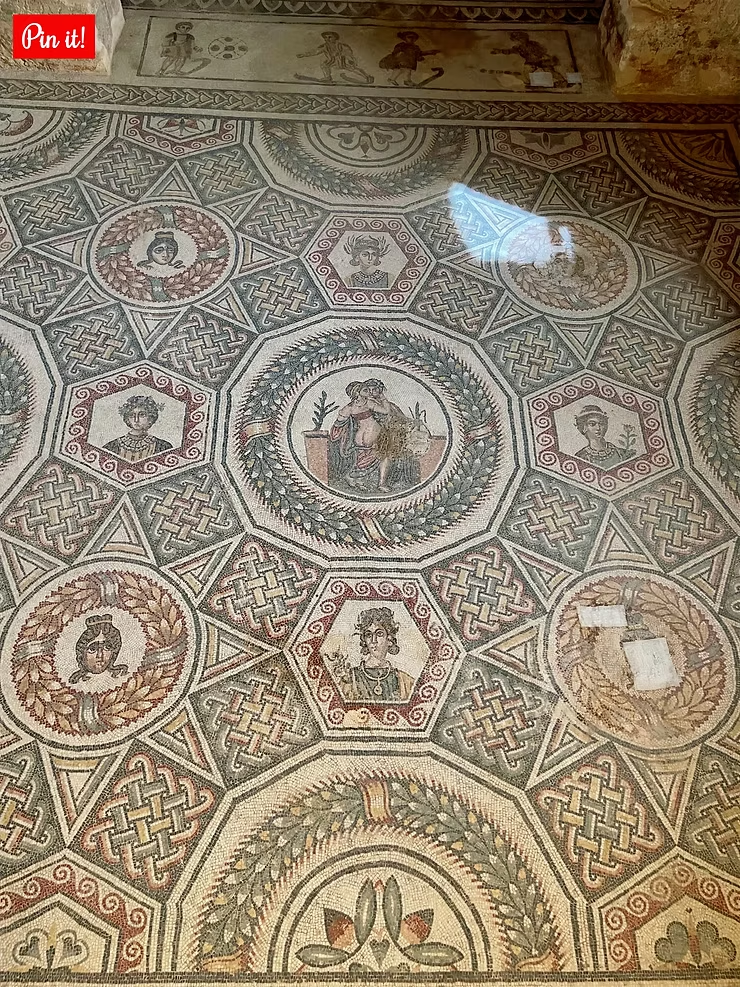As a lover of art and history, mosaics have always caught my attention throughout my travels. While existing on a continuum, Roman mosaics and Byzantine mosaics evolved to become quite different from each other. Ancient roman mosaic patterns included recurring geometric motifs as well as elaborate mythologic, hunting, and sporting scenes. Byzantine mosaics, which succeeded the Roman era, were bedazzled with glittering gold, incorporated precious stones, and often centered on imperial and religious figures. This blog shares five fantastic ancient Roman mosaics and five spectacular Byzantine empire mosaics. Check them out!
The Alexander Mosaic in Pompeii, Italy (Roman)
Pompeii is a city frozen in time. Thanks to the 12 meters of ash and lava that buried the city in 79 AD, a window into ancient Roman life was preserved for millennia until archaeologists unearthed the city. The most well-known artifact uncovered from the Pompeii excavations are the plaster casts of bodies, but one of the greatest mosaics in the Roman empire was also preserved under all that ash – the ‘Alexander Mosaic.’
The huge (8 x 16ft!) mosaic once decorated the floor of what is now known as the House of the Faun in Pompeii, the largest home in the city. Today, the original hangs in the National Archaeology Museum of Naples, but a replica mosaic is located at its original location in Pompeii.
The incredibly detailed and artistic art piece depicts Alexander the Great and his troops battling those of the Persian King Darius III, at the Battle of Issus (333 BC). Alexander himself is shown to the left, riding into battle on his horse. The Persian King is shown fleeing on his chariot, with his forces in disarray.
The mosaic stands out because, from a distance, it looks like a painting. It is uncharacteristically complex for a Roman mosaic, using foreshortening and shadowing effects. One and a half million tiles were used to create the intricate scene. It is truly a masterpiece and worth seeing on a trip to Pompeii.
The replica in Pompeii, Italy:

The original displayed in the National Archaeological Museum in Naples, Italy:

Baths of Neptune Mosaic in Ostia Antica, Italy (Roman)
Ostia Antica, an expansive archeological site in what used to be Rome’s seaport, is home to the remains of 24 bath complexes. Ostia Antica is about 15 miles from Rome, and it’s worth visiting to see one of the more impressive bathhouses, the Baths of Neptune.
The thermal baths of Neptune were built near the end of Emperor Hadrian’s rule in the 2nd century AD. Baths in the Roman Empire served a social function along with a hygienic one. Bathers used the space to conduct business, eat a meal, or seduce a romantic partner.
The Baths of Neptune included a gymnasium, hot, cold, and warm baths, dressing rooms, and an entrance hall with two magnificent mosaics on its floor. One depicts Neptune, the god of the sea, riding a chariot drawn by seahorses and surrounded by various marine animals. The other, in the adjacent room, shows his wife, Amphitrite, riding a seahorse.
The mosaics are created from white and black tiles, in a style that was used throughout many spaces in Ostia. These mosaics are particularly well-preserved, and the images depict active scenes of gods and animals from the sea. As Ostia was a harbor town, the use of marine imagery seems especially appropriate!
For visitors to Ostia Antica, there is an elevated platform adjacent to the Baths of Neptune, from which you can look down on the floor mosaics. Informational plaques identify the figures in the mosaic and share information about the function of a Roman bathhouse.
Aldborough Fort Mosaic in Yorkshire, UK (Roman)

Villa of the Birds Mosaic in Alexandria, Egypt (Roman)
Within the Kom el-Dikka complex, you will also find the Villa of the Birds, which is the ruins of an ancient Roman mansion that still has some intact mosaics on the walls and floors. It is believed that the mosaics have been laid down in the 1st century AD and they are in very good condition. The colorful Birds Mosaic represents different species of birds, as well as geometric motifs.The bird mosaic could have been one of the bedrooms of the villa. It is adjacent to the dining room, the biggest space in the villa. One of the floors has a mosaic with a panther centerpiece. The villa was discovered in 1998, beneath the wall of a Byzantine building. The Villa of the Birds is a fantastic example of ancient Roman design and style. It is one of the few remaining structures from Alexandria’s Roman era.
Bikini Girls Mosaic in Villa Romana del Casale in Sicily, Italy (Roman)
Intended as a room for the servants of the residence’s matriarch or Domina (Eutropia), the rectangular ‘Bikini Girls’ cubicle interestingly had two overlapping mosaic floors, for even in ancient times women seemingly loved redecorating! The original mosaic, as can be seen in the top left-hand segment of the flooring, was a simple geometric motif dated to the 3rd c. AD. Once the owner tired of that pattern and wanted a change in the decor, craftsmen from the Constantinian period (320 AD) laid a new and fun mosaic atop the geometric one, featuring ten bikini girls!
Armenian Bird Mosaic in Jerusalem (Byzantine)
Basilica of San Vitale Mosaics in Ravenna, Italy (Byzantine)
Madaba Map Mosaic in Madaba, Jordan (Byzantine)
The mosaic is about the Holy Land sites and depicts 157 captions in Greek of the major biblical sites from Palestine to Egypt. You can only see about a quarter of the original map, but still get a good feeling of the Holy Land. For example, you can see Mount Sinai, the Dead Sea, fish swimming in the Jordan River, and prominently in the center, Jerusalem.
Next to the church is an exhibition of the map. Visit this exhibition first, for it explains a lot about the map and makes it easier to recognize the various sites when you see the actual map.
Constantine and Justinian Mosaic in the Hagia Sofia in Istanbul, Turkey (Byzantine)
Pantocrator Mosaic in Monreale, Sicily (Byzantine)
The Cathedral of Monreale on the outskirts of Palermo, Sicily is also known as ‘The City of the Golden Temple.’ Germanic invaders, the Normans, gradually settled, occupied, and ultimately overtook the island of Sicily beginning in the 11th century under Roger I. With full papal endorsement and a desire to restore Christianity to the area previously taken over by Arabs, the Normans built massive fortress churches throughout Sicily. Under William II, ecclesiastical authority was transferred to Monreale, just outside of Palermo, where a monastic Abbey was established between 1172-1176 AD. The resultant cathedral, by way of the splendor and magnificence of its architecture, boldly displayed the regal power and wealth of the Norman sovereigns.
Upon entering the cathedral you see gleaming golden and polychrome tesserae on every wall column and arch, reaching out into every conceivable space. Over an area of 8000 square meters, radiant mosaics pictorially tell the story of the Christian faith beginning with Creation, the Old Testament stories, the Life of Christ, the Apostles, and ending with the Evangelists announcing the word of Christ and His church to the world. The mosaics were not just decorative, but intent on conveying a message aimed at the very often illiterate populace… a message of faith in Christ the Savior.
The crown jewel of the mosaics is not surprisingly Jesus, the Pantocrator, looming large in the apse vault over the main alter. The entire image spans 13 meters. Jesus is wrapped in rich pleated robes and His arms are extended, welcoming all. His right hand is held in a gesture of a blessing and in His left hand he holds a bible opened to a page in the gospel. The gospel inscriptions are written in both Greek and Latin and read ‘I am the light of the world. He who follows shall not walk in the darkness.’ He is surrounded by his Heavenly Court of angels, prophets, and saints.
The entire cathedral is spectacular aesthetically, architecturally, and artistically. If you travel to Sicily, be sure to include a visit to Monreale so you can experience this treasure firsthand.
So, there you have it …
Ten stunning mosaics for you to seek out and admire as you travel the vast stretches of the former Roman and Byzantine Empires. On those journeys, you will undoubtedly see MANY, MANY more such mosaics. I hope you are on the lookout for these beautiful works of art and slow down long enough to appreciate the fine craftsmanship of the ancient Roman and Byzantine artists.





